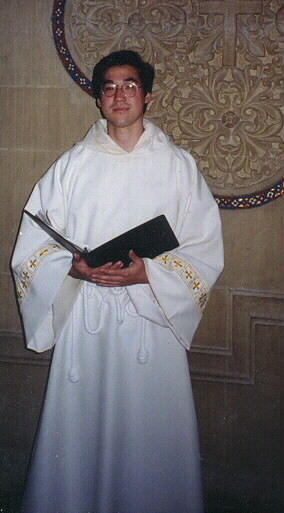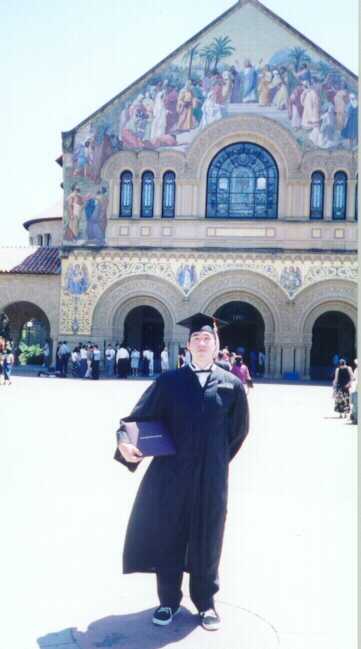A visit to the
Leland Stanford Memorial Church,
Stanford University,
Palo Alto, California
Golden Gate Baptist Theological Seminary /
Mill Valley Campus
P1611 Introduction to Worship /
Dr. Gary W. McCoy /
Spring 2003

by
Chris A. Foreman / Box 780 / April 18, 2003 (Maundy Thursday)
I first visited the Leland Stanford Memorial Church in 1993. This was the year that my older son, Zachary, was a high school senior and began applying to colleges. Like many of his generation who had spent their life on the west coast, his first two college picks were in the East. He wanted to get away far from home. When Harvard and MIT chose not to admit him, Zachary "settled" for Stanford. We didn't tell Zachary at the time, but this result was the one that his mother and I had been praying for. Stanford University turned out to be close enough to Mill Valley that our older son remained a part of our lives for another five years. (As an aside, Zach and I discovered that his Stanford residence was exactly one "Orff" away from our front door. One Orff equals fifty-five minutes or the length of time it takes for CARMINA BURANA to perform one time in the CD player.) While researching the Memorial Church on the web, I found several excellent sources. Since I could not say the words better myself (in some cases I simply lack the technical vocabulary), I will include them in this assignment, noting their web addresses. When Zachary was seriously thinking about attending Stanford, we drove down to visit the campus for the first time. We were immediately drawn to the center of campus and to the Memorial Church. It was an amazing sight, like coming upon some great edifice misplaced from Europe. "There are few buildings with as striking a visual impact. When approaching the structure from virtually any angle within the inner quadrangle, one is awe struck by the magnificent mosaics which adorn the exterior facade. (http://religiouslife.stanford.edu/memorial_church/history.html)" After admiring the exterior for a while, we went inside for a look. This is how one visitor describes the architecture. "It would be best to describe this chapel as a mixture of styles. The basic structure is Romanesque, covered with mosaics of biblical scenes on the outside. Inside, the Arts and Crafts Movement architecture is brightened by touches of Islamic, Baroque and Byzantine architectural flourishes. The interior walls are covered with mosaics. They have the gold background of pre-Renaissance International Gothic paintings, yet the figures have the painterly quality of Rococo or Pre-Raphaelite paintings. The total effect is sumptuous, awe inspiring. The gold tiles on the mosaics sparkled in the light, surrounding you with an unearthly glow. The church is mostly a tourist attraction by day, however various chaplaincies at the school hold services there, and there is a non-denominational service each Sunday. As you walk into the courtyard of the church, there are full-size bronze reproductions of Rodin's "Burghars of Calais" - magnificent sculptures which are the artistic epitome of self-sacrifice for the good of one's community. (http://ship-of-fools.com/Mystery/2001/256Mystery.html)" |
|
This page details the history of the Memorial Church. "Stanford Memorial Church stands at the center of the campus, the University's architectural crown jewel. It was one of the earliest and is still among the most prominent interdenominational churches in the West. It was built by Jane Stanford as a memorial to her husband, Leland. Together, Senator and Mrs. Stanford had built the University as a memorial to their only son, Leland, Jr.
|
This is truly a "non-denominational" church. I have yet to figure out exactly what that title implies. What does it mean to say of the Stanfords that they were "deeply religious, but not committed to a denomination"? This kind of church could only have been constructed in the late 19th and early 20th century. If the church had been constructed earlier, it would have had a denominational affiliation (Catholic, Presbyterian, Episcopal, Methodist). If the Stanfords had begun a campus after 1950, there probably would not have been a church at all. But if one, then the church would have probably been a humble sidelight and not a stunning centerpiece. Everything about the church reflects its fuzzy non-denominationalism. There are elaborate stone angels and portraits that look like apostles, but without names affixed. There are images of Jesus in stain glass and images of Bible stories on the front facade. Many decorative touches do look Byzantine or even Islamic. Many different groups make use of the facility. High mass has been celebrated by Roman Catholics and homosexual unions have been blessed by the Metropolitan Church.
While Zachary was at Stanford one of his friends stayed with us, working as a summer intern at Lukas Art Studies. Her name is Eva and she will be getting married to Ernie on June 21st of this year. We have been invited back to the Memorial Church for this wedding. Eva tells me she had to reserve space for her June wedding two summers ago! I would encourage anyone in visiting the Bay Area to check out the Stanford Campus, and especially to tour the Leland Stanford Memorial Church. |
 After Zachary became a Stanford student, we visited the Memorial Church many times for musical events. It is a habit of college students to shorten the names of common places on campus. The Leland Stanford Memorial Church became shortened to "MemChu". After Zachary eased into the Catholic Church, we would attend Catholic services with him. The picture to the left, is Zachary posing after a concert of religious music. Note the marble inlay that has Christian symbols in an Islamic design.
After Zachary became a Stanford student, we visited the Memorial Church many times for musical events. It is a habit of college students to shorten the names of common places on campus. The Leland Stanford Memorial Church became shortened to "MemChu". After Zachary eased into the Catholic Church, we would attend Catholic services with him. The picture to the left, is Zachary posing after a concert of religious music. Note the marble inlay that has Christian symbols in an Islamic design. During Zac's time at Stanford, we must have visited the Memorial Church a dozen times. On one occasion my wife and I met Chelsea Clinton, and on another occasion as we were sitting in the back of the church, we saw the back side of Bill as he sat in front with Chelsea. We experienced Handel's Messiah, Mozart's Requiem, and Orff's Carmina Burana at "MemChu". To the left is Zachary posing after graduating from Stanford in 1998.
During Zac's time at Stanford, we must have visited the Memorial Church a dozen times. On one occasion my wife and I met Chelsea Clinton, and on another occasion as we were sitting in the back of the church, we saw the back side of Bill as he sat in front with Chelsea. We experienced Handel's Messiah, Mozart's Requiem, and Orff's Carmina Burana at "MemChu". To the left is Zachary posing after graduating from Stanford in 1998.